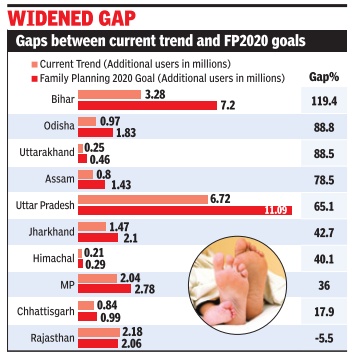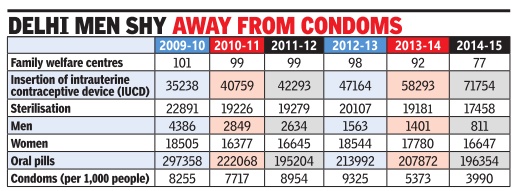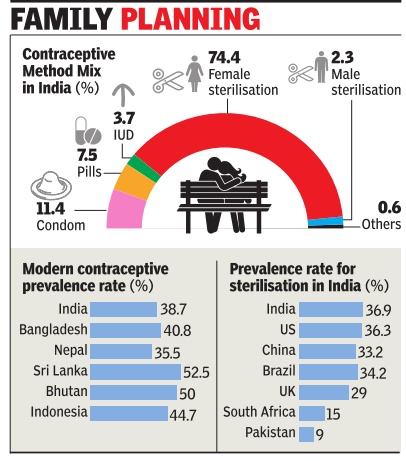Family planning: India

This is a collection of articles archived for the excellence of their content. |
Contents |
Contraception
2015: high contraceptive prevalence
The Times of India Jan 02 2016
Sushmi Dey
India's Mix Of Birth-Control Methods Poor
India has been attracting severe criticism from the international community for its poor mix of contraceptive methods. This despite India registering the highest contraceptive prevalence rate for sterilisation at 36.9% as compared to other countries with similar demographics. The US trails India recording a 36.3% rate, China follows at 33.2% and Brazil at 34.2%.
The huge share of female sterilisation coupled with slow pace in adoption of other modern contraceptive methods have raised concerns internationally about women's rights as well as health risks.
Latest data presented by a global partnership Family Planning 2020 (FP2020) showed female sterilisation accounts for 74.4% of the modern contraceptive methods used in India. An additional 3.7% of the same is IUD. As against this, male sterilisation is merely 2.3%, while use of condoms account for 11.4%.Use of pills make just 7.5% of modern methods, whereas injectables and implants are almost absent.
Compare this with 32.1% of female sterilisation, 28.5% injectables, 15% of pills and 10.4% of condoms used as a share of modern contraceptive mix in Sri Lanka. The country has 52.5% modern contraceptive prevalence rate (mCPR).Bhutan, which has 50% mCPR, also accounts for 44.2% of injectables, 10.9% of female sterilisation and 19.3% of male sterilisation as part of the modern method mix.
This also assumes significance in the wake of concerns related to India's rising population and the government's continuous efforts to contain the decadal growth rate Various international agencies including the United Nations, have projected that India will be the most populous nation by 2022.
The government has recently taken steps to improve the cover age and create more awareness about family planning, mainly in rural areas. To ensure a greater thrust on spacing methods, the health ministry has also created specific schemes for Accredited Social Health Activists (ASHAs) to ensure spacing in births.
Besides sterilisation, the Centre is trying to increase the basket of contraceptives and making them available under the national family planning programme. India has introduced injectable contraceptive as part of the scheme. “India must increase the number of users of modern contraceptives so that a greater proportion of all women and girls of reproductive age are served. Offering more types of modern methods in family planning programs will result in higher use,“ says Poonam Muttreja, executive director, Population Foundation of India.
India's population growth rate has declined significantly from 21.54% in 1991-2000 to 17.64% in 2001-11. Government data says, India's total fertility rate has declined from 2.6 in 2008 to 2.3 in 2013 and India is now just 0.2 points away from reaching the replacement level.
So far, 24 states have already achieved replacement level fertility. Nearly 60% of the population resides in states where either replacement fertility is already reached or will soon do. These include West Bengal, Maharashtra, Gujarat and Punjab.
However, 11% more male children are born every year as compared to females, as against a benchmark of 5%, shows UN data.
Two child norm for public servants
Madhya Pradesh: Rules for government and panchayat officils
The Times of India, Jul 03 2016
Deshdeep Saxena
3 peons flout 2-child norm in MP, sacked
Three peons, posted at Madhya Pradesh's Damoh district court, have been sacked for violating the state's two-child norms. Kalyan Singh Thakur, Chanda Thakur, and Lalchand Burman were sacked on June 23, after a year-long departmental inquiry found out that they had violated the norm that was added to MP civil services rules in 2000.Sources said 11 more peons are facing similar action for violating the norm.
However, Kalyan pointed out a similar rule, barring people from contesting panchayat polls was amended, but poor people like them were being punished. “Poll eligibility rules of politicians were changed in 2005. I am finished, I need Rs 4,000 for admission of my son. I am finished.What would I do now? he said. Thakur said the government would need to sack lakhs of employees if the rule is implemented.
The three, who would move the high court, were found to have violated the norm two years earlier, after then district judge V P Shrivastava had sought family details of employees, including the number of children born after January 26, 2011. They were served sho-cause notices in December 2015 and given 15 days to reply , before a departmental inquiry in March found them guilty of norm violation.
Women-centric?
An arena only for women

See graphic, 'Family planning only for women...'
Women and reproductive choices
2016 survey
Sushmi Dey, '4 of 5 sterilised women have 3 or more kids', Feb 12 2017: The Times of India
Even as female sterilisation continues to be the most common contraceptive method used in India, it has failed to address the problem of population control. Almost four out of every five sterilised women had three or more children, shows a 2016 survey , signifying that around 80% of the women mainly in high burden states had already achieved their desired fertility when going for sterilisation.
The findings of the married women in reproductive age survey by International Center for Research on Women (ICRW) also highlighted the average age of sterilisation in high burden states like Uttar Pradesh and Bihar is 27 years, indicating that most women had achieved their desired fertility even before reaching half of their reproductive lifespan.
The findings were discussed during an ongoing Difficult Dialogues Summit in Goa. Based on the deliberations made by politicians, policy makers, academicians and health experts during the three-day summit, the forum will submit a list of recommendations to PM Narendra Modi demanding policy interventions.
“These data indicate that there is imbalance between the information that women are receiving about reproductive choices and the factors that are influencing those choices,“ ICRW vice-president, Asia Ravi Verma told TOI. Verma said contraceptive users do not have adequate knowledge about the range of methods available for spacing and limiting but more importantly , they also do not have enough knowledge about the current method they're using. While discussing the impact of gender inequality on health, experts also raised concerns about poor mix of contraceptive methods in India. India has the highest contraceptive prevalence rate for sterilisation at 36.9% as compared to other countries with similar demographics. The US trails with 36.3% rate, whereas China's sterilisation rate is at 33.2% and Brazil at 34.2%.
“Women are subject to huge discrimination when it comes to receiving health services. Not only is the use of female sterilisation high but often their consent are also not taken for methods like Postpartum Intrauterine Contraceptive Device (PPIUCD),“ said N B Sarojini, director of Sama Resource Group on Women and Health, an NGO that focuses on public health and regulation issues.
Official data suggests female sterilisation accounts for 74.4% of the modern contraceptive methods used in India. An additional 3.7% of the same is IUD. As against this, male sterilisation is merely 2.3%, while use of condoms account for 11.4%. Use of pills constitute just 7.5% of modern methods, whereas injectables and implants are almost absent.
Compare this with 32.1% of female sterilisation, 28.5% injectables, 15% of pills and 10.4% of condoms used as a share of modern contraceptive mix in Sri Lanka.
The panel of experts are going to recommend bringing in more stability by promoting use of modern contraceptives like condoms and injectables to improve the method mix, while also giving women more rights and increase awareness to protect her reproductive right.
Delhi, 2009-15: Women shoulder responsibility
The Times of India, December 10, 2015

DurgeshNandan Jha
Family planning women's burden
The national capital is not just battling a skewed sex ratio and women's safety , but also lagging behind in ensuring equality as far as family planning is concerned. Data shows that the onus of family planning predominantly rests with women.They account for 95% of sterilisations conducted at various family welfare centres in the state.
What is even more worrisome is that the number of men seeking sterilisation has gone down in last five years.
In male sterilisation, surgeons cut and seal the tube that carries sperm from the testicles to the penis.
Doctors say this is less painful and complicated compared to female sterilisation that involves cutting, sealing or blocking the fallopian tubes.
Statistics released by Delhi government on Wednesday show that in 2009-10 men accounted for 20% of all sterilisations. It reduced to 14% in 2010-11, 13% in 2011-12, 8% in 2012-13, 7% in 2013-14 and 5% in 201415. “This clearly reflects the bias against women. They are forced for sterilisation and other contraceptive methods while men shirk heir responsibility,“ said Dr Suneeta Mittal, director and head of obstetrics and gynaecology , Fortis Memorial Research Institute, Gurgaon. Apart from sterilisation the public health system provides three other contraceptive services -combined oral contraceptive pills, intrauterine devices (IUCD) and condoms -to people through family welfare centres.
Usage of only IUCD, a device inserted into the uterus to stop pregnancy , has gone up over the last five years.Sterilisation and distribution of oral pills and condoms have gone down. Experts link this to decline in the number of family welfare centres from 101 in 2009 10 to 77 in 2014-15.
Recently , North Delhi Municipal Corporation closed down nearly 20 family welfare centres allegedly due to lack of funds. Other centres run by civic bodies and the state closed due to lack of manpower.
“The centres are important for giving information on family planning and offering contraceptive services. Also, we may need to include counselling against sex selection at these centres,“ said Dr Abha Mazumdar, senior gynaecologist at Sir Ganga Ram hospital.
